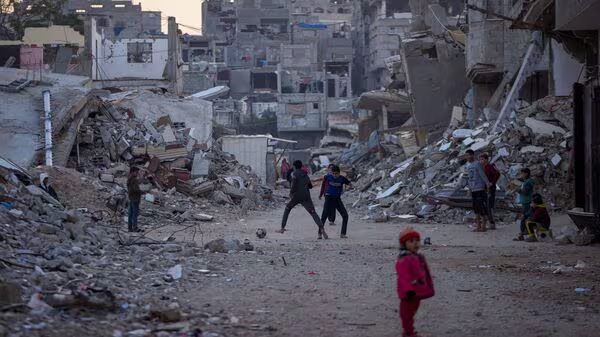On January 16, 2025, Qatar’s Prime Minister, Sheikh Mohammed bin Abdulrahman bin Jassim Al-Thani, announced a breakthrough agreement between Israel and Hamas, signaling a potential pause in the brutal conflict that has raged for over 15 months. The ceasefire deal, set to take effect on Sunday, January 19, 2025, also includes provisions for a hostage and prisoner exchange. While this development offers hope for peace, its future remains uncertain.
Key Provisions of the Ceasefire Deal
The ceasefire agreement outlines several important provisions aimed at reducing the immediate humanitarian crisis in Gaza and advancing the potential for long-term peace. The most significant of these provisions includes the phased release of hostages held by Hamas, as well as the release of hundreds of Palestinian prisoners held in Israel. The exchange is seen as a critical step toward building trust between the two sides.
Another key element of the agreement is the return of displaced Palestinians to their homes. Over 500,000 people in Gaza have been displaced due to the ongoing conflict, with many of them living in temporary shelters or makeshift camps. The deal promises that they will be allowed to return to their homes, which have been devastated by airstrikes and ground fighting.
Furthermore, the deal facilitates the flow of humanitarian aid into Gaza. With the region in dire need of food, medical supplies, and basic necessities, this provision is expected to alleviate some of the worst effects of the conflict on the civilian population.
Doubts and Setbacks: Will the Ceasefire Hold?
Despite the optimism surrounding the deal, the announcement of the ceasefire has been met with caution. Israeli Prime Minister Benjamin Netanyahu has expressed concerns, accusing Hamas of backtracking on the terms of the agreement. Netanyahu’s statement casts doubt on whether the deal can be fully implemented as planned, with obstacles still standing in the way of a lasting ceasefire.
Israeli officials have also delayed a planned cabinet vote on the ceasefire, a critical step in formally approving the agreement within Israel. The delay reflects the complexities involved in securing approval for such an agreement, especially given the deep divisions within Israel’s political and military leadership. Hardline factions within Israel may resist any concessions to Hamas, making it unclear whether the ceasefire will be ratified by the Israeli government.
Continued Violence: The Risk of Escalation
Even after the announcement of the ceasefire, violence has continued in Gaza. Israeli airstrikes have intensified in the days following the deal’s announcement, killing at least 40 Palestinians. This uptick in violence underscores the fragility of the ceasefire and raises concerns that it may not hold once implemented. The ongoing military actions suggest that, for now, both sides may be testing the waters to see if the other is truly committed to the ceasefire.
Hamas has also warned that any Israeli violations of the ceasefire could lead to a resumption of hostilities. With such high stakes and a history of broken ceasefires, both sides are likely to approach the deal with skepticism and caution, increasing the chances that it may fail before it can truly take effect.
The Humanitarian Impact
For the people of Gaza, the ceasefire represents a potential lifeline. The conflict has taken a devastating toll on the civilian population, with thousands of lives lost and entire neighborhoods reduced to rubble. Access to basic services such as healthcare, food, and water has been severely restricted, exacerbating the suffering of those caught in the crossfire.
The promise of humanitarian aid flowing into Gaza as part of the ceasefire deal is a critical component of the agreement. The international community has been urging both sides to allow aid to reach those in need, and this deal offers an opportunity to address the immediate humanitarian crisis. However, the continued violence and the fragile nature of the ceasefire raise questions about whether aid will actually reach the people who need it most.
The Role of Hostages and Prisoners
The exchange of hostages and prisoners is another key aspect of the agreement. The release of Israeli hostages held by Hamas and Palestinian prisoners held in Israeli jails has the potential to reduce tensions and build confidence between the two sides. The swap is likely to be an emotional and highly charged process, with both sides facing pressure from their respective constituencies.
For the families of those held captive, the prospect of reunion is a source of hope. However, the process of releasing prisoners is often complicated, with political and security concerns playing a central role. Any delays or disagreements over the details of the exchange could quickly escalate tensions, derailing the ceasefire before it can take hold.
🚨NEW: Biden comes out and takes credit for TRUMP’S hostage and ceasefire deals in Gaza…
UNBELIEVABLE! pic.twitter.com/DrTkPUjZrn
— David J Harris Jr (@DavidJHarrisJr) January 15, 2025
The Future of Peace
While the ceasefire agreement represents a significant step toward reducing violence in Gaza, its long-term success is far from guaranteed. The deeply entrenched mistrust between Israel and Hamas, combined with internal political challenges on both sides, makes it difficult to predict whether the deal will result in lasting peace. The path forward will require both sides to act in good faith and show a willingness to compromise on key issues, including the status of prisoners, humanitarian aid access, and the security concerns of Israel.
As the world watches closely, the ceasefire deal remains a fragile step toward peace, with the potential to either bring relief or lead to further escalation. The coming days and weeks will be crucial in determining whether this fragile agreement can hold, or if the violence will continue to rage unabated.

